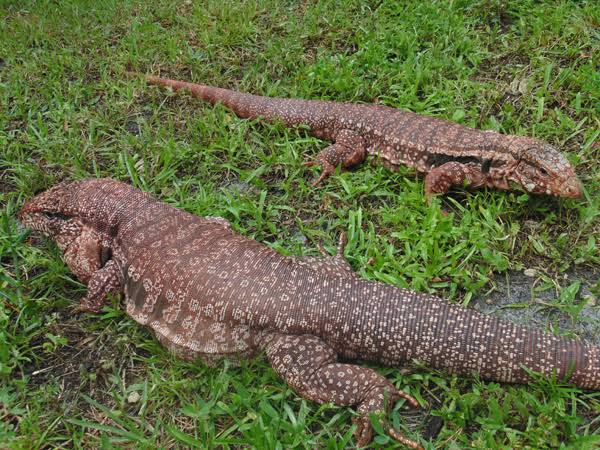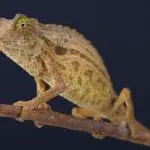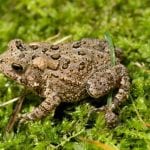Exotic pets such as reptiles that come from all parts of the world can be some of the most difficult animals to take care of for any owner, especially if he or she is still new to the exotic pet trade. Even seasoned exotic pet owners can still find it too difficult of a task to take care of or handle exotic pets that are not too common in the industry. After all, not all reptiles are made to be taken care of the same since most of these exotic pets have their own unique traits and requirements for them to thrive well under captive care.
That said, the Salvator Tegu is one of those reptiles that can be tricky for any owner to take care of even if the said owner has already had a bit of experience in caring for similar exotic pets. These animals used to be very popular in commercial markets not as pets but as commodities used in the reptile skin trade. In some cases, locals also hunt them for their meat, but such cases have since decreased ever since the turn of the new millennium. As such, these reptiles were not known as pets but as commodities. That is why taking care of one might be a bit difficult.
But you do not need to fret about that as we have everything you need to know to get to understand the Salvator Tegu better and for you to know how to take care of these exotic pets when keeping them under your captive care.
What is the Salvator Tegu?
General Information
The Salvator Tegu is a species of reptile that is native in many places in South America. You can find this lizard in regions such as Brazil, Argentina, Uruguay, Paraguay, and other places close by. In those countries, these reptiles were once the favorite of local hunters because of how valuable they are in the reptile skin trade and as local delicacies in places that actually love to eat reptile meat. But ever since their numbers declined, they are now hunted down to a lesser degree as the population of Salvator Tegus are now closely monitored.
They have since been introduced to South and Central Florida. In the United States, they have considered an invasive species because they are not native to Florida’s ecosystem. As such, they are usually hunted down to sell them for their skin or as pets to those who are willing to take in exotic reptiles such as a Salvator Tegu.
Physical Description
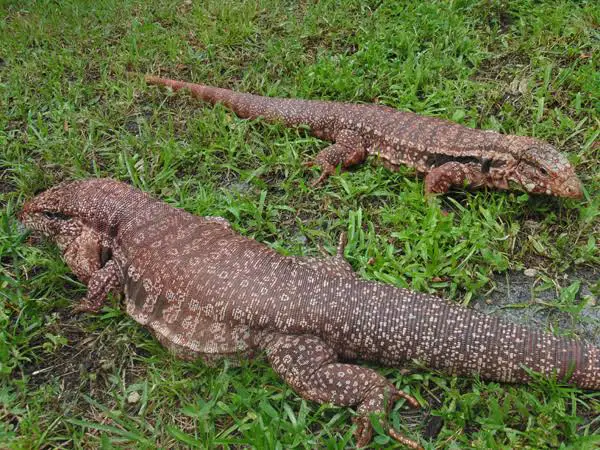
Considered to be a reptile that is quite large, the Salvator Tegu can reach a total head to tail length of about 4 feet and can weigh as heavy as 15 pounds. There is some specimen that can reach a total length of at least 5 feet. The male Salvator Tegu tends to look bulkier or stockier than the females and have jowls that are rounder and bigger than their counterparts because of how they are naturally more muscular. The size of this lizard can only mean that it is not something that is so easy to take care of because of how its large size can be a problem for a lot of households that prefer to keep smaller exotic pets.
Salvator Tegus differ from their other tegu cousins in the sense that they can be bigger and that they have a color that is unique to their kind. Salvators, as mentioned, can grow to lengths of about 5 feet while other tegus barely grow over 4 feet long. The Salvator Tegu also usually carries a reddish to a dark brown color scheme that differs in the shade in all of the different parts of the reptile’s body. The markings on this lizard’s body tend to be a lighter shade of brown. Meanwhile, some subspecies of tegus are closer to gold or yellowish-brown in terms of their color.
They may have a similar build and overall appearance to that of monitor lizards, but Salvator Tegus are actually not as closely related to monitors as one might think. In fact, they are very far off relatives. You can easily see the differences between them if you inspect them closely enough. Salvator Tegus have larger heads but shorter necks. They also have bigger and more muscular bodies compared to monitor lizards.
Behavior
The Salvator Tegu tends to be an opportunistic hunter that likes to look for any kind of advantage when hunting down its prey. They like to hunt for prey that tends to be smaller than they are and usually use their prey’s normal eating pattern to know where they are. As such, when it is hunting for fruit-eating mammals, it tends to use scattered fruit on the ground as a way to look for its prey. This means that these reptiles are naturally smart and inquisitive animals that are quite easy to learn anything about their surroundings, especially when it comes to food.
While baby Salvator Tegus tend to be shy creatures that do not hesitate to run away from a potential threat, a wild adult Salvator Tegu does not back down from a fight; it thinks it can win. These adult reptiles do not have a lot of natural predators in the wild and are well aware that they have the size and strength to fight off anything they deem as a threat. Its usual predators in the wild tend to be really large birds of prey, big cats, bigger lizards, and larger species of snakes. But even if they are up against larger predators, they will not hesitate to defend their skin. Salvator Tegus have jaws that are so strong due to their natural muscular build that they can crus human fingers in just a single bite. This means that these reptiles are not to be taken lightly of by potential predators and humans alike.
Eating Habits
Salvator Tegus differ from a lot of other reptile species in the sense that they are actually omnivorous animals instead of just sticking to the usual reptile diet that is composed of meat or invertebrates. In the wild, these creatures will normally feed on a wide variety of food such as fruit, invertebrates, small invertebrates such as rodents, carrion, fungi, or eggs. As invasive species in Florida, they are often found digging through alligator nests to eat the eggs of these much larger reptiles.
Studies have shown that the Salvator Tegu’s diet is actually dominated by fruits and plant material as these lizards can have a usual calorie intake that is 66% fruit. Meanwhile, the rest of their calorie intake is usually divided between invertebrates and vertebrates, but they tend to consume invertebrates at a slightly higher rate than they do vertebrates probably because it is easier for them to get their mouths on large quantities of small insects they can easily feed on.
Care Tips for the Salvator Tegu
Caging
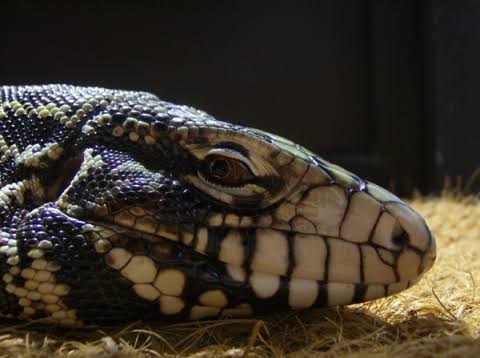
When you are housing a Salvator Tegu in captivity, the one thing you need to concern yourself with first and foremost is the size of the cage. Due to how large the Salvator Tegu is, you need to make sure that you keep it in an enclosure that is proportional to the size of the lizard. For example, hatchlings that can be about 10 inches in terms of their length can be kept in a breeder tank that is about 40 gallons large. Meanwhile, larger juveniles and adults should be kept in a cage or enclosure that is about 6 feet long, 3 feet wide, and 3 feet high. For bigger specimen, you may want to keep them in enclosures that can be about 8 feet long and 4 feet wide.
The best substrate to provide your Salvator Tegu is cypress mulch because it can be similar to what these lizards usually experience in the wild and because this type of substrate is great at retaining moisture to keep humidity levels in the enclosure at a level that is steady and acceptable enough for these reptiles. The substrate should be about 8 inches deep for adults because Salvator Tegus do have a tendency to dig holes.
Heating, Lighting, and Humidity
Since the Salvator Tegu is used to living in the tropical and warm climates of South American countries, it is very important that you make sure to provide it enough heat and humidity inside its enclosure. The first thing you need to make sure is to use a combination of heat lamps and a UVB light to keep the ambient temperatures somewhere close to about 75 degrees Fahrenheit. The basking spot should be the hottest portion of the enclosure and should have temperatures that can be 90 to 95 degrees warm. Meanwhile, the UVB lamp is to make sure it gets enough ultraviolet B lights to help provide it with the vitamin D it needs for calcium metabolism.
For the enclosure’s humidity, the first thing to take note of is to allow air to pass through in and out of the Salvator Tegu’s cage to improve airflow. A screen roof or door should do the trick here. Also, keep the substrate moist by misting the enclosure on a regular basis. Once the substrate dries out, mist it again. A large water bowl should also serve a dual purpose of hydrating your lizard and keeping the enclosure humid.
Food and Water
The Salvator Tegu is not a particularly difficult lizard to feed because of its tendencies as an omnivore. Studies have shown that its usual calorie intake can be composed of more than 50% fruit while the rest is divided between invertebrates and vertebrates. That means that your choice of food for your Tegu is almost unlimited, but you should still make sure that you provide it with a balanced enough diet to keep it healthy.
Younger Salvator Tegus need a lot more protein than adults do to promote the muscular build that this lizard is known for. As such, feed babies and juveniles with a lot of insects for protein, but make sure to dust those insects with calcium to make up for the high phosphorous levels found in insects. Crickets, mealworms, and cockroaches can be good insects for your juveniles to eat. Meanwhile, adults can be fed with thawed or live mice or other types of rodents, fruits, eggs, and even vegetables because of how varied their diet is. It is always best to mix and match the type of diet you provide your adult Salvator Tegu so that it gets to experience a more balanced type of diet.
Salvator Tegus will regularly drink water from a standing source such as a pond. In captivity, keep a large water dish inside its enclosure as these lizards may not only want to drink out of it but may also want to take a dip in the dish to keep their bodies hydrated. But keep an eye on how clean the water in the dish is and make sure to replace it regularly to avoid any kind of water-borne disease caused by contamination.
Handling the Salvator Tegu
It can be a bit tricky and difficult to handle the Salvator Tegu. Babies and juveniles are very shy because they view everything around them larger than anything they know. That means that they easily get scared and will run away when they detect any sort of threat. Meanwhile, adults can be somewhat defensive and will try to fight off any incoming threat. In that case, expect this exotic pet to be quite the difficult one to handle.
Captive-bred Tegus are easier to tame than wild-caught ones. It is also important that you get Salvator Tegus that have grown used to being around humans since their younger days. In all other cases, the best way to approach this lizard is to avoid eye contact as much as possible. Try to stay calm and gentle at all times without making any sudden moves with your limbs so as to avoid startling this reptile.
In some cases, owners take their Salvator Tegus to a smaller room such as a bathroom and allow them to freely roam around it while the owner is in there so that it will get used to having its human around and realize that its owner is not a threat. And when the reptile gets used to its owner, it might even crawl up to him or her and have bonding moments. The best owners who are able to tame their Salvator Tegus can even safely put a leash on their necks and walk them around like they are dogs.

